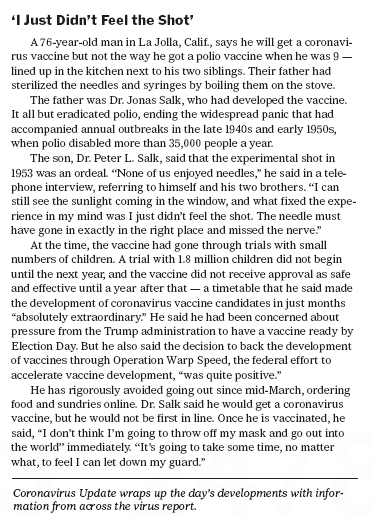In similar stories told in books by Grove and by Christensen and Raynor, technology firms work better when large, if components require careful design to work well together. When components become standardized and interchangeable, technology firms work better when smaller, buying components from specialized component suppliers. Deciding what is best at any moment requires uncertain judgement, and can change over time. In the passages quoted below, it appears that Apple thinks better performance can be achieved by integrating a key component back within the firm.
(p. B4) Apple Inc. built its gadget empire by outsourcing production to a vast ecosystem of chip makers and other component specialists. Under Chief Executive Tim Cook, it is taking a lot of that business back.
The company, which released its first iPhone processor in 2010, said Monday [June 22, 2020] it plans to ship Macs later this year with custom chips, a move that ends a 15-year technology partnership with Intel Corp. Apple said the custom-designed chips are more efficient and offer higher-performance graphics.
. . .
The strategy springs from Apple’s philosophy—fostered by its late co-founder Steve Jobs—that owning core technologies provides a competitive edge. Customized chips and sensors can help its iPhone, iPads and Macs leapfrog rivals in battery performance and features. It also can protect Apple from Chinese rivals that buy universally available parts.
. . .
The initiative—called insourcing by some suppliers and analysts—can give Apple a two-year jump on competitors in device performance because Apple can plan how multiple chips work together to limit power consumption and free up space inside iPhones and iPads for other components, analysts said.
It also reduces potential leaks of its product plans.
For the full story, see:
(Note: ellipses, and bracketed date, added.)
(Note: the online version of the story was updated June 24, 2020, and has the title “Apple Is the Newest Chip Giant in Town.”)
The Grove book mentioned above is:
Grove, Andrew S. Only the Paranoid Survive: How to Exploit the Crisis Points That Challenge Every Company. New York: Bantam Books, 1999.
The Christensen and Raynor book mentioned above is:
Christensen, Clayton M., and Michael E. Raynor. The Innovator’s Solution: Creating and Sustaining Successful Growth. Boston, MA: Harvard Business School Press, 2003.


